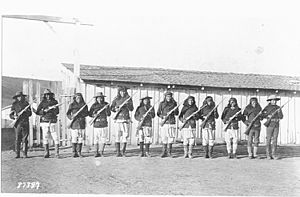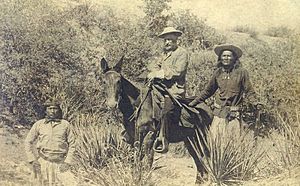Apache Scouts facts for kids
Quick facts for kids Apache Scouts |
|
|---|---|

Apache scouts at Fort Apache, Arizona, in the 1880s
|
|
| Active | 1860s - 1947 |
| Country | |
| Branch | |
| Type | Indian scouts |
| Engagements | Chiricahua War Navajo War |
The Apache Scouts were a special group of Native American soldiers. They worked with the United States Army for many years. Most of their service was during the Apache Wars, from 1849 to 1886. The last Apache scout retired in 1947.
These scouts were like the "eyes and ears" for the U.S. military. They helped by finding enemies and understanding the local land. They also helped translate between different Apache groups and the American soldiers. Apache scouts fought in other conflicts too. These included the Navajo War and the Mexican Border War. They even served in the U.S. during World War II. Many Apache Scouts were recognized for their bravery.
Contents
Apache Scout Groups
The term "Apache" actually refers to several different tribes. These tribes are related and live in the Southwestern United States. They include the Chiricahua, Jicarilla, and Western Apache. Each group had its own traditions and lived in different areas.
Apache Scouts were usually grouped by their tribal band. This helped them work together better.
Tonto Apache Scouts
Tonto Apache scouts were very important. They helped General Crook find Chief Delshay's group. This group had left the Fort Verde reservation. Albert Sieber, a chief of scouts, often worked with Tonto scouts. They were with him through much of the Apache Wars.
White Mountain Apache Scouts
White Mountain Apache scouts served with Lieutenant Charles B. Gatewood. This was from 1885 to 1886. General George Crook praised them highly. He said they were "subordinate, energetic, untiring and... most efficient."
These scouts helped track Geronimo's group for 16 months. But after the war, they were sent to Florida. They were held as prisoners of war for 26 years. This was the same fate as Geronimo's band, even though they had helped the army.
Warm Springs Apache Scouts
Warm Springs Apache scouts also played a big role. They served under Lieutenant Britton Davis. They were in the field tracking Geronimo and Nana.
In 1885, Mescalero scouts helped Major Van Horn's cavalry. They tried to stop Geronimo and Nana from crossing the Rio Grande. This was near Fort Stanton.
Apache Scout Service History
Mescalero Apache scouts helped the army during the Navajo War. This was in 1863 and 1864. One important battle happened on January 4, 1864. It was along the Pecos River in New Mexico Territory.
About 100 Navajo warriors had raided a reservation. An Indian agent led 60 Mescalero scouts to chase them. They found the Navajo at the Pecos River. The Navajo had stolen livestock and tried to defend it.
U.S. Army soldiers soon arrived to help. After a long fight, the Navajo had to retreat. They left behind about 40 dead. The Americans and Apache scouts had no casualties. They also got back 50 horses and mules.
Less than two weeks later, Colonel Kit Carson led an expedition. They went into Canyon de Chelly. This was a main area for the Navajo. Most of the Navajo living there were captured. This helped end the war.
Yavapai War Service
Apache scouts were used throughout the Apache Wars. Around 1870, General George Crook had a new idea. He wanted to enlist whole companies of scouts. At first, few Apaches joined him. So, he recruited Native Americans from many tribes. These included Navajos, Pimas, and Yavapais. He also had some Mexicans and Americans.
General Crook allowed captured Apache men to join his scouts. He believed that "the wilder the Apache was, the more he was likely to know the wiles... of those still out in the mountains."
While recruiting, Crook also fought against the Western Apaches and Yavapai. This was in central Arizona Territory. During the Tonto Basin Campaign in 1872, Crook used his scouts. They fought at the Battle of Salt River Canyon on December 28. Over 100 Yavapai and Tonto people were in a cave. Crook attacked with cavalry and scouts. The battle resulted in many deaths and captures.
The general won another victory at Turret Peak. This was on March 27, 1873. More Yavapai and Tonto Apache were killed. Soon after, many Yavapai and Tonto groups surrendered.
Small groups of Yavapai and Apache continued to raid. This went on for two more years. General Crook left Arizona in 1876. Colonel Augustus P. Kautz took over the scouts. He formed more companies in 1877 and 1878. Kautz wrote that these scouts were "exceedingly efficient." He said they were "a great terror to the runaways." He also noted they were "more efficient than double the number of soldiers."
Border War Service
After Geronimo surrendered in 1886, fewer Apache scouts were needed. By 1891, there were only 50 left. In 1915, only 24 remained.
However, in March 1916, Pancho Villa attacked Columbus, New Mexico. General John J. Pershing was ordered to go into Mexico. His mission was to capture or kill Villa. Pershing allowed 17 new Apache scouts to join. This brought the total to 39 men.
Pancho Villa and his rebels were in Chihuahua. Pershing led his army across the border. The scouts were split into two groups. One group went from Fort Huachuca, Arizona. They joined the 10th Cavalry Buffalo Soldiers. The second group left from Fort Apache. They joined the 11th Cavalry.
By the time the scouts arrived, the hunt for Villa was stopped. This was because of a battle where Americans fought Mexican government troops. The hunt never started again. Pershing then occupied northern Chihuahua. Later, he slowly pulled his troops back to the United States.
The first battle for the scouts was at Ojo Azules Ranch. On May 5, a small group of scouts joined the 11th Cavalry. They attacked about 150 Villistas. Sixty-one Mexicans were killed. Another seventy were captured. The American side had no casualties.
The expedition ended in February 1917. The army then reduced the scout force. Only 22 scouts remained on duty. But their service was not completely over. Conflicts between the U.S. and Mexican armies continued until 1919. Mexican raids across the border also happened frequently into the 1920s.





